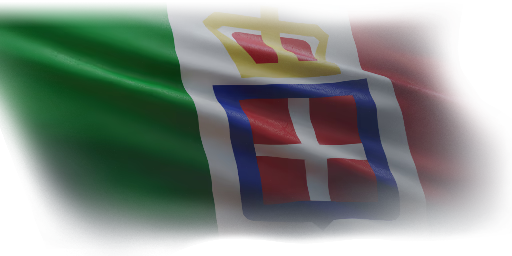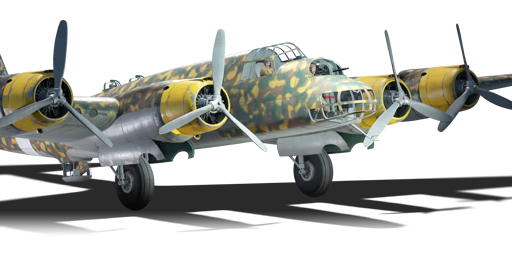

Aviation
P.108B serie 1
III
Rank
AB
3.7
RB
3.3
SB
3.3
Battle rating
Italy
Research country
Bomber
Main role
18,000

Research
47,000

Purchase

Kingdom of Italy
Operator
General information
The P.108B serie 1 is an Italian bomber. It was introduced in Update 1.69 "Regia Aeronautica".
The P.108B Serie 1 is a heavy bomber with a heavy bomb load and relatively weak defensive armament. When delivering the bombs to the targets, high altitudes are a must. The preferred targets of this bomber are stationary objects like pillboxes or slow moving vehicles such as ships (if you can time it well) and of course the bombing targets and airfields. Should an enemy fighter catch up with you, it is certain doom as your defensive guns have a low chance to kill it. To survive attacks, use your gunners to ward off the enemy aircraft until help comes. Stay away from combat as much as you can and do your job as a bomber.
Camouflages
Flight performance
Max speed
at 3,900 m
419389438401 km/h
Rate of Climb
4.32.46.52.5 m/s
Turn time
3638.734.837.3 s
Max altitude
9,000 m
Takeoff Run
750 m
Landing
flaps
flaps
Take-off
flaps
flaps
Combat
flaps
flaps
Air
brake
brake
General characteristics
Crew
8 persons
Engine
Length
22.9 m
Wingspan
32 m
Wing Loading
194 kg/m²
Weight:
Base weight
19.2719.8618.7919.76 t
Fuel in main tanks
6.95 t (4h 15m)
Limits:
Max Speed Limit (IAS)
515 km/h
Mach Number Limit
0.65 M
G limit
≈ -2/3 G
Flap Speed Limit (IAS)
L / T / C
249 / 361 / 383 km/h
Gear Speed Limit (IAS)
290 km/h
Defensive armament
2 × Turret — 12.7 mm Breda-SAFAT machine gun
Ammunition
750 rounds
Fire rate
700 shots/min
One-second Burst Mass
0.41 kg
| Belt | Belt filling | Armor penetration (mm) at a distance: | |||||
|---|---|---|---|---|---|---|---|
| 10 m | 100 m | 500 m | 1000 m | 1500 m | 2000 m | ||
| T/Ball/AP/AP/HEF | 21 | 19 | 12 | 7 | 4 | 2 | |
| AP/AP/AP/API-T | 21 | 19 | 12 | 7 | 4 | 3 | |
| API-T/AP-I | 21 | 19 | 12 | 7 | 4 | 3 | |
2 × Turret — 2 × 12.7 mm Breda-SAFAT machine gun
Ammunition
1,200 rounds
Fire rate
700 shots/min
One-second Burst Mass
0.41 kg
| Belt | Belt filling | Armor penetration (mm) at a distance: | |||||
|---|---|---|---|---|---|---|---|
| 10 m | 100 m | 500 m | 1000 m | 1500 m | 2000 m | ||
| T/Ball/AP/AP/HEF | 21 | 19 | 12 | 7 | 4 | 2 | |
| AP/AP/AP/API-T | 21 | 19 | 12 | 7 | 4 | 3 | |
| API-T/AP-I | 21 | 19 | 12 | 7 | 4 | 3 | |
2 × Turret — 7.7 mm Breda-SAFAT machine gun
Ammunition
800 rounds
Fire rate
900 shots/min
One-second Burst Mass
0.15 kg
| Belt | Belt filling | Armor penetration (mm) at a distance: | |||||
|---|---|---|---|---|---|---|---|
| 10 m | 100 m | 500 m | 1000 m | 1500 m | 2000 m | ||
| T/Ball/Ball/AP-I/AP | 13 | 12 | 7 | 3 | 2 | 0 | |
| T/AP/AP/AP | 13 | 12 | 7 | 3 | 2 | 0 | |
| T/AP-I/AP-I/AP-I | 13 | 12 | 7 | 3 | 2 | 0 | |
Suspended armament
Setup 1
34 × 50 kg GP 50 bomb
Setup 2
34 × 100 kg GP 100T bomb
Setup 3
2 × 450 mm W 170/450/5.46 torpedo
Setup 4
3 × 450 mm W 170/450/5.46 torpedo
Setup 5
7 × 250 kg GP 250 bomb
Setup 6
7 × 500 kg GP 500 bomb
Economy
Repair cost
Basic → Reference
AB
987 → 1,342 

RB
1,752 → 2,383 

SB
3,060 → 4,162 

Crew training
13,000 

Experts
47,000 

Aces
400 

Research Aces
280,000 

Reward multiplier
AB / RB / SB
70 / 150 / 250 % 

136 % 

Total cost of modifications
19,660 

32,100 

Talisman cost
980 

Research order:
Flight performance | |
|---|---|
Survivability |
|---|
Weaponry | |
|---|---|
Rating by players
You must play more than 3 battles for the last week and more than 10 battles in a vehicle to rate it.
Like:
12
Flight performance:
Not enough ratings
Survivability:
Not enough ratings
Aerial combat:
Not enough ratings
Ground attack:
Not enough ratings
Balance:
Not enough ratings
Tips & Tricks
This space is currently empty
Do you know any interesting vehicle features?
Loading...
No articles about this vehicle yet
Become the first author and get rewards!
Write a guide, tell about interesting historical facts, make a tutorial or simply an interesting post.
No more content